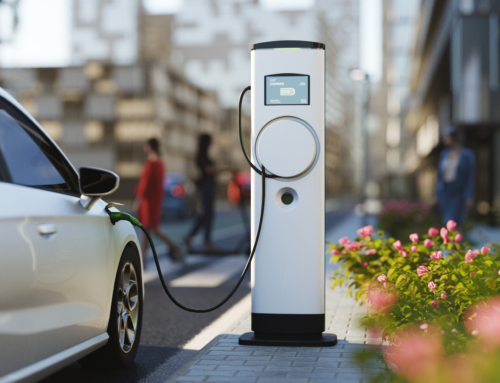Are you thinking about switching to an electric vehicle (EV)? This green decision offers many advantages for both the environment and the buyer.
In this article, you’ll learn all about the environmental benefits of electric cars, other types of eco-friendly vehicles available, and how these cars impact your wallet. It’s essential to do your research, so we encourage you to dive into this guide to get started on the right foot.
What Makes a Car Electric?
An electric vehicle runs entirely on electricity instead of gas. The electricity is generated and stored by internal batteries that can be recharged.
There are three main types of EV batteries:
- Lithium-ion batteries: These batteries are found in most electronics like your smartphone and computer. Most EVs run on lithium-ion batteries. They carry a large battery life per unit mass, and most lithium-ion batteries are recyclable.
- Lead-acid batteries: Generally used as a backup, lead-acid batteries are primarily used to supplement battery loads in EVs. They’re inexpensive and safe, but they have a short lifespan, making them challenging to use as the main power source.
- Ultracapacitors: Ultracapacitors store electrical energy via polarized liquid. When the liquid level increases, so does the energy. Like lead-acid batteries, ultracapacitors are usually used as backup batteries since they help level out load power. The polarized liquid can also be useful in supplying EVs with extra power when you’re accelerating or driving up a steep hill.
Electric vs. Gas
To give you a better idea of what electric cars are and how they work, here are some of the key points that differentiate them from gas-powered vehicles:
- EVs only have a motor, while standard vehicles have exhaust systems, water pumps, etc. With fewer moving parts than gas-powered cars, EVs typically require less maintenance.
- Electric cars accelerate faster than gas-fueled cars, which is why electric vehicles typically feel lighter to drive.
Electric Cars and the Environment
Electric vehicles are a fantastic option for anyone serious about doing their share of environmental preservation.
Research illustrates that electric vehicles emit fewer greenhouse gases and air pollutants than gas-fueled cars, even taking the batteries into account. Though some of the battery’s energy does derive from fossil fuels, EVs produce significantly fewer emissions to power up over their lifetime than a standard gas-fueled car.
Energy experts agree that as EVs become more energy renewable in the years to come, their emission rates can be reduced by as much as 75 percent by the year 2050. Currently, the standard EV in the U.S. emits roughly 200 grams of carbon dioxide for every mile. Compare this to the standard vehicle, which emits about 404 grams per mile.
In 2050, the rate at which EV emits CO2 is estimated to decrease to 50 grams per mile.
Electric Cars and Costs
The effects of electric cars not only positively impact the environment but your finances as well. According to the University of Michigan’s Transportation Research Institute, EVs generally cost significantly less to operate than a gas-powered vehicle, less than half in some states.
More specifically, the average cost to use an EV is roughly $485 a year, while the average for their counterpart is over $1,000. The price differences will vary depending on your geographic location’s gas and electric rates and the type of vehicle you drive.
Additional Notes to Keep in Mind
As you’re browsing through electric cars, keep the following in mind:
- EVs may be more expensive upfront, but as more EVs become available, the costs are decreasing.
- The only downside to owning an electric vehicle is making sure it’s always charged so you’re never without power. Electric cars need to be charged at least once a day and can take up to eight hours to reach a full charge.
- Before buying this type of car, make sure it has the capability of getting you through your regular commute. It’s also important to take your local community into account:
- Have they adapted to electric cars?
- Are there available charging stations throughout the city while you’re out running errands or meeting a friend for lunch?
Other Types of Eco-Friendly Cars to Consider
There are also other types of green vehicles available. Keep in mind, not all green vehicles deliver the same impact.
As you begin your search, it’s important to familiarize yourself with:
- The different types of eco-friendly vehicles
- How they operate
- How hybrid cars affect the environment
Use our guide below to find the perfect green car for you.
1. Diesel
Did you know that switching from a gas-powered car to a diesel-fueled engine can positively affect the environment? While this change isn’t as substantial as switching to an electric vehicle, it’s still an improvement. By converting from gas to diesel, you can reduce the daily greenhouse gas emissions you contribute to the atmosphere. You can also increase your fuel economy for better gas mileage.
2. Eco-Friendly
More and more car companies are finding ways to appeal to eco-conscious consumers by making their vehicles less harmful to the environment. Eco-friendly cars offer a “green driving” mode you can switch on and off to improve gas mileage and reduce fuel emissions.
This go-green driving mode makes moderate changes to the driving experience, like shutting off the engine when the car is at a full stop or reducing accelerating power.
3. Hybrid
A hybrid vehicle runs on both gasoline and electricity. The cooperation between an electric and internal combustion engine system reduces emissions while increasing fuel economy.
Overall, hybrid vehicles are known for their unbeatable miles per gallon, which can save you money in the long run. The vehicles are commonly run by nickel-metal hydride batteries. These batteries require fuel to be recharged and are known to hold a longer lifespan than lithium-ion batteries.
However, there is such a thing as negative effects of hybrid cars on the environment. This particular type of vehicle is praised for being eco-friendly, but it puts off more harmful emissions than most people think. In addition, nickel-metal hydride batteries are high in cost compared to other batteries used in green vehicles.
Generally speaking, however, a hybrid vehicle is less harmful to the environment than a traditional gas-powered vehicle.
4. Plug-In Hybrid
The plug-in hybrid is another eco-friendly car that combines the power of gasoline and electricity. What makes this type of vehicle a lot more beneficial for the environment than the original hybrid is that they only run on gasoline if they have to.
Because it’s possible for this vehicle to run on electricity alone, owning one will greatly reduce your carbon footprint with lower fuel-related emissions. You’ll also save a ton of money on gas, especially during times when fuel prices escalate.
Keep in mind, while more and more charging stations are popping up all over the country, they’re not always accessible. Gasoline is only used when the car battery runs out of power and can’t be charged, so always have a backup plan.
Learn More about Eco-Friendly Tips
Are you an eco-conscious consumer who strives to make small changes to preserve the world in which we live? Get more lifestyle tips by reading through our resources on Spring Power & Gas’ blog. Explore a variety of subjects such as solar farms, recycling tips, and even how to save and conserve energy. If you have any questions, don’t hesitate to contact our team.




![Top 11 Sustainable Building Practices for Eco-Homes [Plus 5 Sustainable Materials]](https://springpowerandgas.us/wp-content/uploads/2023/02/iStock-181062267-500x383.jpg)

